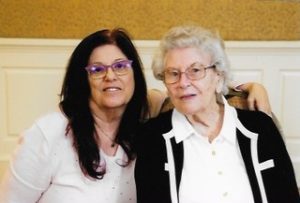In Which Trina Discusses the Different Types of Journals and Explains Their Best Use
By Trina O’Quinn for the NABBW
-

Trina and her mother
In my last blog, written just before my mother’s death on January 2, 2022, I wrote about the difference between using journals and diaries.
At the end of the post, I said that my next blog would cover several different types of journals and how you can best use them.
I am a bit late, as life got in the way, but here is the promised blog.
I will start with some guidelines for effective journal writing:
- Forget the “rules.” Penmanship, grammar, and spelling are not important. Write what/however you want. Write with pencil and paper as the computer can take you out of the right brain.
- Start with a quieting process to help move your thoughts from “out there” to “in here”—breathing, visualizing, focusing, relaxing, and entrance meditations. I personally start by slow stitch which is breath work while I embroider.
- Date every entry. It allows for chronological reconstruction. And it makes it easier to track cycles, patterns, and trends.
- Keep what’s written or destroy it with intention. Often writing that feel superfluous contain seeds for future insight. If there is a strong impulse to purge the journal, do so from a place of choice and strength rather than defensiveness, fear, or shame.
- Write quickly…so quickly that the dreaded inner-critic and inner-censor can’t catch up!
- Tell the truth…even when it is difficult, scary or negative. (Corollary: Pennebaker’s “flip-out rule” — if writing it down will make you flip out, don’t write it.)
- Protect privacy. Store the journal in a special place so the temptation for others to read it is diminished. Keep the first page as a title page. Ask others to respect your privacy.
- Give permission. Use different journal techniques, allow for personal preferences, and find a style that works.
As promised here are a few of the journaling styles I have in my personal wellness tool box.
Note: These are just six types of journaling examples. There are many more. I have used most of them and these are my personal favorites. I find that when I can not figure out what is bothering me, it helps to just pick up my pen and write. I find it helpful if I do a feed back write in all my journaling.
1. Sentence Stem
- A sentence completion process. Finish the below sentences with a word or a phrase.
- This is the most simple way of journaling.
- Sample sentence starters:
- I want…I feel…I need
- Today I want to …Since I last journaled…What I learned… I can use this learning…
- What I can do next…
- Timed writing is designed to bring focus and intensity in short bursts. Can be expanded to 7-10 minutes.
- Excellent for those of us that procrastinate, are time challenged, or resistant or averse to journal writing.
- Useful to ease into hidden thoughts and feelings.
- Can help set goals or renew them.
- Writing sprints at regular intervals on the same subject allows tracking of feelings, projects, issues overtime.
- Some suggestions:
- Right now, in my life, I am thinking about…
- As I read this I notice…(or, I am aware of … I am curious about… Feel…etc.)
- Taking inventory of a question, problem, issue, obstacle, etc… to build a bridge from “where I am” to “where I want to be.”
- Helps break down overwhelming situations into manageable steps.
- Some areas to inventory might include health, family, finances, relationships, work, home, habits, patterns, etc… Questions might include:
- Where am I now?
- Where do I want to be?
- When do I want to be there?
- What are the actions steps to get there?
- What is my first step
- A series of stem sentences grouped and sequenced to reveal consistency deepening layers of information and awareness.
- Developed to get an aerial view of key issues instead of a head-first dive.
- Promotes self awareness
- Can be completed in 10-15 minutes. 1-2 minutes per stem.
- The basic writing structure is:
- Todays Date____Start time____Three words describing how I feel right now: ____ ____ ____
- I want to explore…
- The first thing that comes to mind….
- Beneath the surface I find…
- I feel anxious (scared, restful, mad) about…
- I feel hopeful (good, okay, at peace) about…
- My next step is…
- Three feeling words ____ ____ ____ End time____
5. Unsent Letter
- A letter written to another person with a specific intention that will not be sent or shared with the person.
- Besides free writing, this is the most common way for people to say what they are thinking or feeling.
- Offers immediate cathartic relief and a safe place to be temporary out of control.
- You can establish a ritual to burn or tear up the unsent letter once it has served its cathartic purpose. This symbolizes the hapless release of discharged emotions.
- Can serve as behavioral rehearsal of actual communication.
- Intentionally a one-way communication; a good choice when one’s voice has been silenced.
- This unstructured, un-boundaried, free form narrative starts anywhere and goes where it pleases.
- Free writing is a place most people start in the absence of another idea, but it is not always the most effective, efficient, or helpful choice.
- Begin by beginning: Dive in and follow the pen.
- Excellent for meditation and connection with inner guidance.
- Watch for natural and organic shifts in voice, perspective, or awareness. Frees up creative expression with spontaneous and unexpected connections.
Finally, here is a recommended way to end each journaling session.
As I read this I am:
- surprised by…
- aware of…
- curious about…
- I notice…
- I feel…
I also find it helpful to have paper and a writing instrument with me at all times. I have found over the last 30+ years that journaling helps me write my way to both mental, physical, and spiritual wellness.



Leave a Reply
You must be logged in to post a comment.